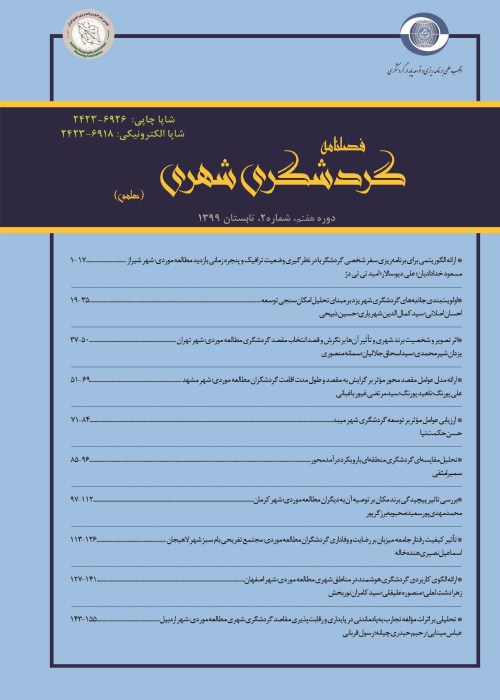Investigation of the relationship between the tourist attractions and land use by using geographical weighted regression model (case study: Isfahan, Iran)
Author(s):
Abstract:
Identifying the factors affecting tourism attraction, such as services and installations will help in the planning of tourism. Large touristic cities are often faced with numerous problems. The placement of tourist centers in the historic and traditional structures of cities has doubled these problems. Thus according to the placement of tourist attraction centers of Isfahan in traditional structure, this question is expressed that how the spatial patterns and arrangement of tourist attractions and land uses are in Isfahan? Is there a certain order or spatial pattern for their arrangement? Are tourist attractions and land uses linked together or are they distributed randomly in space? This study has been done in order to make tourist spatial planning for Isfahan with emphasis on relationship between tourist attractions and land use. The hexagonal lattice has been used as basic unit for combining the original data that each diameter of hexagonal is 500 meter, and finally the whole city was divided into 2383 hexagonal lattices. The research method is descriptive - analytical. In order to answer research problem, weighted regression model was used. Results show agriculture is the most normal index. Industries have the most positive and negative impact on tourism attraction simultaneously. Cultural spaces and green areas have the most positive effects on tourism attraction and health care centers have the greatest negative effects on it. In addition, the least impact is related to the education and agencies indexes.
Methodology of research:In this study, Polygons data (surface) of tourist attractions and Isfahans land use were used. Data is related to the year 1385 and was provided by the municipality of Isfahan in the form of separated layers. The research method is analytical- descriptive and in order to answer the questions of the research weighted regression method was used. One of the important parts of this present study is the determination of spatial analysis scale and the size of hexagonal cells. Because if the scale of these hexagonal lattices get too small, false spatial pattern will be formed in space and modifiable areal unit problem cause loss of information in the spatial lattices of the city if the dimensions be considered too big(Good child, 2011), (Baller et al. 2001).
Introduction
The recognition of affecting factors such as services and installations on tourism attraction can help in the planning of tourism and have a significant impact on performance and satisfaction of tourists. Most large and touristic cities themselves are faced with numerous problems and this, especially in old cities with traditional structure placed in their centers, has made it difficult to service residents. Therefore, to reduce or prevent negative impacts of tourism, it is necessary to take action for the determination of spatial patterns of tourist and organization of the tourist areas, and in order to provide facilities and civil services such as hotels and resorts, the means of access and transportation, enhancing cultural and artistic attractions, tourist services and encouraged rules, develop a comprehensive program to benefit not only from the local and regional tourists but also from national and international tourists in order to make better use of urban spaces especially in touristic areas to increase incomes and employment and general prosperity. In this study Isfahan, touristic center was evaluated to determine the relationship between the tourist attractions and land use by using geographical weighted regression model. Isfahan is one of the most famous traditional cities in Iran because of its Islamic architecture, with many beautiful boulevards, covered bridges, palaces, mosques, and minarets. There are questions that ask how are the land use patterns and spatial arrangement of tourist attractions of Isfahan? Is there a certain order or spatial pattern? Are attractions tourist and land uses linked together or distributed randomly in space?Methodology of research:In this study, Polygons data (surface) of tourist attractions and Isfahans land use were used. Data is related to the year 1385 and was provided by the municipality of Isfahan in the form of separated layers. The research method is analytical- descriptive and in order to answer the questions of the research weighted regression method was used. One of the important parts of this present study is the determination of spatial analysis scale and the size of hexagonal cells. Because if the scale of these hexagonal lattices get too small, false spatial pattern will be formed in space and modifiable areal unit problem cause loss of information in the spatial lattices of the city if the dimensions be considered too big(Good child, 2011), (Baller et al. 2001).
Results And Discussion
A hexagonal lattice was built for modeling and integrating information. In this study Isfahan was divided into 2383 hexagonal grids, and a unique code was assigned to each grid cell. In order to aggregate data, analysis of overlap (Intersect) and the summarization and summarization connection with right triangle lattice was conducted. Then, based on network code, information layers of each land uses was given to the cells. In next step, the cells that had no important information were deleted and finally 1272 cells were remained and spatial analysis was done related to remained data. Sing geographical weighted regression (review of land use impacts on tourism), the output of each column was normalized, and the resulting data were analyzed in seven categories.Conclusion
Geographical weighted regression method is a statistical technique that has been adapted for the study of local patterns. This method is in fact a local statistical technique that analyzes the relationship between spatial variables in a non-stationary assumed environment and one of its objectives is to overcome the limitations of the OLS model. This study has tried to introduce the effects of some indexes on spatial pattern of tourism. This indexes are not all parameters affecting tourist attractions, because the tourist attractions are in close connection with other uses. However, according to the available data, 17 indexes were evaluated for the determination of their effect on tourism attraction: landscaping, parking, sports complexes, industrial, medical and health care centers, educational centers and etc. The results show that agricultural is the most normal index. Industries have simultaneously the most positive and negative impact on tourism. Cultural spaces and green areas have the most positive effects and health centers have the greatest negative impact on tourism. Minimal impact indexes are related to educational and governmental agencies.Keywords:
Language:
Persian
Published:
journal of urban tourism, Volume:2 Issue: 1, 2015
Pages:
1 to 16
magiran.com/p1595796
دانلود و مطالعه متن این مقاله با یکی از روشهای زیر امکان پذیر است:
اشتراک شخصی
با عضویت و پرداخت آنلاین حق اشتراک یکساله به مبلغ 1,390,000ريال میتوانید 70 عنوان مطلب دانلود کنید!
اشتراک سازمانی
به کتابخانه دانشگاه یا محل کار خود پیشنهاد کنید تا اشتراک سازمانی این پایگاه را برای دسترسی نامحدود همه کاربران به متن مطالب تهیه نمایند!
توجه!
- حق عضویت دریافتی صرف حمایت از نشریات عضو و نگهداری، تکمیل و توسعه مگیران میشود.
- پرداخت حق اشتراک و دانلود مقالات اجازه بازنشر آن در سایر رسانههای چاپی و دیجیتال را به کاربر نمیدهد.
In order to view content subscription is required
Personal subscription
Subscribe magiran.com for 70 € euros via PayPal and download 70 articles during a year.
Organization subscription
Please contact us to subscribe your university or library for unlimited access!



